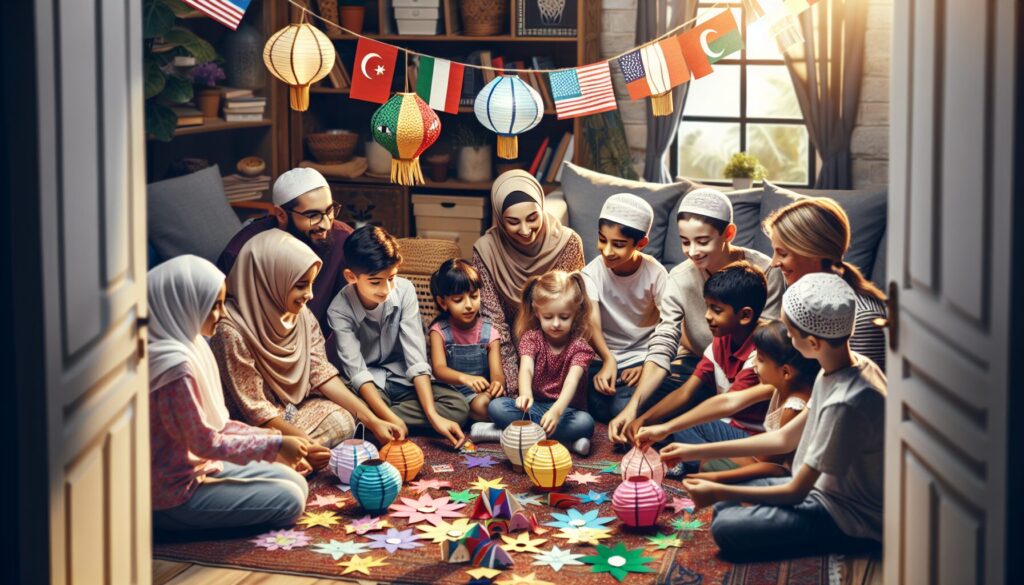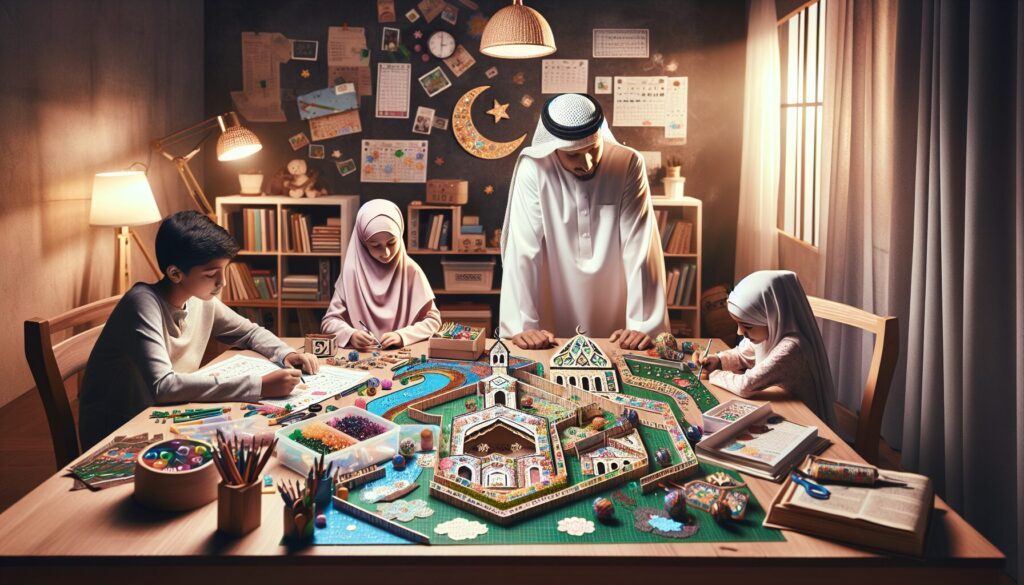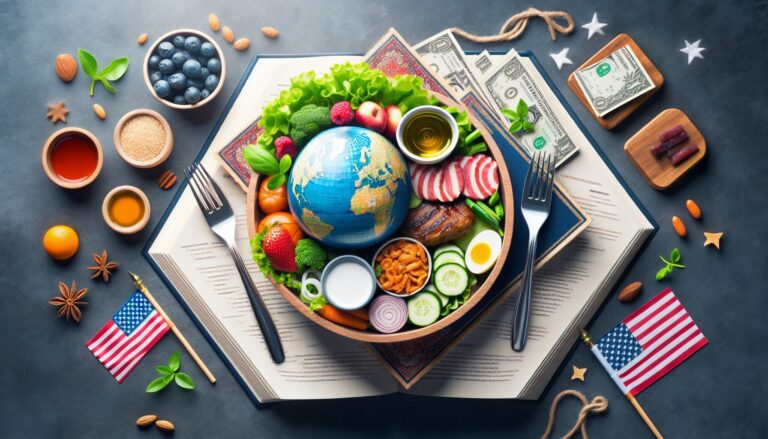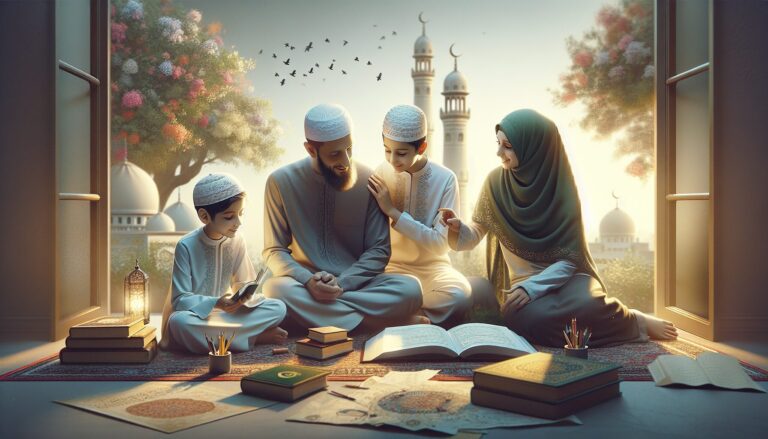Last year, a friend in New Zealand shared a photo of her neighbour’s little ones who had just crafted handmade Ramadan lanterns, their faces absolutely glowing with pride. I knew they’d stumbled onto something magical – Ramadan crafts for kids aren’t just about keeping busy hands occupied! In Aotearoa, where the Muslim community is beautifully woven into the cultural tapestry, it’s clear that creating these special decorations and activities helps children connect with their faith in the most joyful ways. Whether you’re in Auckland, Wellington, or anywhere across the islands, there’s something incredibly special about watching your kids transform simple paper, glitter, and paint into meaningful symbols of this blessed month. From moon and star garlands that catch the afternoon sun to gratitude jars that become family treasures, these hands-on projects spark conversations about faith, patience, and giving that stay with children long after the glue has dried.
Creating Colorful Paper Lanterns and Fanoos Decorations

Paper lanterns and fanoos bring magical illumination to your home during the blessed month, and I’ve discovered they’re absolutely perfect for keeping little hands busy on those long weekend afternoons! Last year, a friend’s kids made dozens of these colorful decorations, and she said their enthusiasm was so contagious that they ended up hosting an impromptu craft session with families from their local mosque.
Traditional fanoos lanterns have been lighting up celebrations for centuries, and creating paper versions lets children connect with this beautiful heritage while developing their creativity. You’ll need colored cardstock or construction paper, scissors, glue sticks, rulers, and some string or ribbon for hanging. Additionally, grab some glitter, sequins, or metallic markers if you want to add extra sparkle – trust me, the kids will thank you!
Start with the classic accordion-style lantern, which even preschoolers can master with supervision. Fold a rectangular piece of paper lengthwise, then cut parallel slits from the folded edge, stopping about an inch from the opposite side. When you unfold and form it into a cylinder, those cuts create beautiful diamond-shaped openings that catch the light gorgeously. Furthermore, this technique teaches children about patterns and symmetry without them even realizing they’re learning geometry.
Advanced Fanoos Designs for Older Children
For children aged eight and above, introduce more intricate fanoos patterns inspired by traditional Islamic geometric designs. These complex patterns require patience and precision, making them excellent for developing fine motor skills and concentration. Create templates using cardboard from recycled cereal boxes – a sustainable approach that many Wellington and Christchurch families have embraced enthusiastically.
The star-and-crescent fanoos design has become incredibly popular among tweens in many Muslim communities. Cut out star shapes from gold or silver paper, then layer them with crescent moon cutouts in contrasting colors. Moreover, you can incorporate verses from the Quran written in beautiful calligraphy, though younger children might prefer using decorative stickers from Crescent Books or similar Islamic supply stores.
Transform ordinary glass jars into stunning fanoos by having children glue colored tissue paper pieces in mosaic patterns. This technique works brilliantly because:
- Battery-operated tea lights make them completely safe for children’s bedrooms
- The jars are reusable year after year, creating family heirlooms
- Children can personalize them with their names in Arabic or English
- They make wonderful gifts for grandparents and elderly community members
Consider organizing a lantern-making workshop at your local Islamic center or through groups like Federation of Islamic Associations of New Zealand. These Ramadan crafts for kids become even more meaningful when created in a group setting where children share stories and techniques. However, remember to prepare extra materials because enthusiasm tends to spread quickly, and you’ll likely have more participants than expected!
Weather-resistant lanterns work wonderfully for outdoor iftar gatherings in your garden. Laminate the paper decorations or use clear contact paper to protect them from our unpredictable autumn drizzle. Therefore, your beautiful creations can brighten up both indoor and outdoor spaces throughout the entire month without worry.
Making Crescent Moon and Star Wall Hangings
Creating crescent moon and star wall hangings is one of the most meaningful Ramadan crafts for kids you can tackle together as a family. These timeless symbols represent faith and guidance, and when your children make them with their own hands, they’re building a deeper connection to their Islamic heritage while developing fine motor skills and artistic expression.
You’ll need basic materials that are readily available at Spotlight or your local craft store: cardboard or foam boards, metallic paper in gold and silver, string or ribbon, scissors, glue sticks, and optional glitter for that extra sparkle. I’ve found that using recycled cereal boxes works brilliantly too – it’s eco-friendly and teaches kids about sustainability alongside their craft project.
Start by drawing templates on plain paper first. The crescent should be about 15-20cm tall, while stars can vary from 5-10cm across. Always supervise younger children when they’re using scissors, and consider having pre-cut shapes ready for preschoolers. Once you’ve got your templates, trace them onto your chosen material.
Assembly Techniques That Work Every Time
The magic happens when you layer different textures and colors. Cut your base shapes from sturdy cardboard, then create slightly smaller versions from metallic paper to glue on top. This creates a beautiful dimensional effect that catches light wonderfully when hung near windows. My kids love adding personal touches like their names in Arabic calligraphy or small geometric patterns inspired by traditional Islamic art.
Threading the hanging mechanism requires patience but delivers professional results. Punch a hole at the top of each shape using a hole punch or carefully with scissors. Thread ribbon through, leaving about 30cm for hanging. You can create a mobile-style arrangement by attaching multiple crescents and stars to a wooden dowel or embroidery hoop – perfect for younger children’s bedrooms.
Furthermore, these wall hangings make thoughtful gifts for neighbors and teachers. Last year, a class at a West Auckland school created a beautiful display where each child contributed one piece, showing how Islamic traditions can enrich the multicultural community. The Islamic Council of New Zealand often features similar community craft projects that bring families together.
For added durability, especially if you’re planning to reuse these decorations year after year, consider laminating the finished pieces or coating them with clear craft sealant. Store them flat between sheets of tissue paper when Ramadan ends, and they’ll remain pristine for next year’s celebrations.
Additionally, you can expand this project by creating different phases of the moon to teach children about the lunar calendar. This educational element transforms a simple craft into a learning opportunity about why we follow moon sightings to determine the start and end of our holy month. Many families also incorporate these handmade decorations into their year-round Islamic holiday craft traditions, using different color schemes for Eid celebrations.
Designing Personalized Prayer Mats and Bookmarks
Creating personalized prayer mats and bookmarks brings such joy to little hands during this special month! I’ve been making these with my kids for years now, and you know what? They’re still using the bookmark they made three years ago – it’s become their absolute favorite. These crafts combine creativity with spiritual connection, and they’re perfect for those rainy autumn afternoons you might be getting in New Zealand.
Prayer mats don’t need to be complicated. Start with a piece of felt or sturdy fabric about 60cm by 40cm – you’ll find great options at Spotlight stores across the country. Let your children choose their favorite colors, and here’s where it gets fun! They can decorate using fabric markers, iron-on patches, or even simple fabric glue with sequins. My youngest loves adding geometric patterns using stencils, while my older one prefers drawing mosque silhouettes.
Materials You’ll Need for Both Projects
Gathering supplies is half the adventure, and most items are readily available at local craft stores. For the prayer mat, you’ll need:
- Felt or canvas fabric (pre-cut pieces work brilliantly)
- Fabric markers or paint pens
- Decorative elements like ribbons, buttons, or foam stickers
- Fabric glue that’s child-safe
- Optional: iron-on transfers with Islamic patterns
Bookmarks require even simpler materials – cardstock, laminating sheets, ribbons, and markers. I’ve found that letting kids use metallic pens makes them feel extra special about their creation. Always supervise young children when using scissors or hot glue guns, and consider pre-cutting shapes for the littlest ones.
The bookmark-making process teaches patience and precision. Cut cardstock into 5cm by 15cm strips, then let creativity flow! Children can write their favorite du’as, draw crescent moons, or create colorful geometric patterns. One technique that’s always a hit is using watercolors first, letting them dry completely, then adding details with fine-tip markers. Laminating these treasures ensures they’ll last through countless bedtime story sessions.
Furthermore, incorporating Māori designs alongside Islamic patterns creates beautiful fusion pieces that reflect our unique Kiwi Muslim identity. A friend shared a photo of her daughter’s stunning prayer mat featuring both Arabic calligraphy and traditional koru patterns – it was absolutely gorgeous! This approach helps children appreciate both their faith and their connection to that beautiful land.
These Ramadan crafts for kids become cherished keepsakes that grow more meaningful over time. Setting up a dedicated craft station in your home makes the process smoother. Use an old tablecloth to protect surfaces, keep wet wipes handy, and play some nasheed in the background to set a peaceful atmosphere. The Warehouse Stationery often has bulk craft supplies at great prices, especially their multipack markers and glue sticks.
Additionally, these projects offer perfect opportunities for teaching moments. While decorating, discuss the importance of prayer, the beauty of taking care of our religious items, and how personalizing these objects helps strengthen our connection to worship. Children naturally open up during creative activities, making it an ideal time for meaningful conversations about faith and practice.
Building a DIY Ramadan Calendar with Daily Activities

Creating a DIY Ramadan calendar transforms the holy month into an interactive adventure that’ll keep your little ones engaged every single day! You know how kids love advent calendars at Christmas? Well, this is our version, and honestly, it’s even better because we’re filling it with meaningful activities that connect our children to their faith.
Start with a large poster board or repurpose that cardboard from your latest online shopping spree – it’s a great way to be sustainable! Draw or print 30 numbered pockets, one for each blessed day. I’ve found that using small paper bags from the local dairy works brilliantly, or you can fold origami envelopes if you’re feeling fancy. Decorate the base with crescent moons, stars, and those beautiful geometric patterns that make Islamic art so distinctive.
Here’s where it gets exciting – instead of chocolates, we’re tucking daily activity cards into each pocket. Mix spiritual activities with acts of kindness to create a balanced experience that teaches both worship and community service. Your calendar becomes a teaching tool that grows with your family year after year.
Daily Activity Ideas That Actually Work
Let me share what’s been absolute gold for my family and what I’ve heard from families across Auckland. For the first week, ease into it with simple tasks that build confidence:
- Day 1: Learn one new Arabic word related to Ramadan
- Day 2: Help set the iftar table without being asked
- Day 3: Donate one toy to the Salvation Army collection bins
- Day 4: Call grandparents and wish them Ramadan Mubarak
- Day 5: Plant herbs for the family (mint grows wonderfully in our climate!)
- Day 6: Create thank you cards for mosque volunteers
- Day 7: Learn about one Prophet’s story at bedtime
As the month progresses, introduce slightly more challenging activities. Maybe on day 15, they’re preparing a simple iftar dish like dates stuffed with almonds. By day 20, they might be organizing a mini food drive with their school friends. The Auckland City Mission always appreciates donations, especially during winter months when Ramadan sometimes falls.
Furthermore, incorporate activities that celebrate the unique Kiwi Muslim identity. Include a day for learning a Māori greeting to share at the mosque, or organizing a beach cleanup after Fajr prayers on the weekend. These Ramadan crafts for kids become more than just activities – they’re building blocks for raising conscientious young Muslims who understand their place in Aotearoa.
Remember to adjust activities based on your children’s ages and abilities. My five-year-old gets simpler versions while her older brother tackles more complex challenges. The key is making every child feel successful and connected to their faith journey. Additionally, leave a few pockets empty for spontaneous family decisions – maybe you’ll discover a neighbor needs help with groceries or decide to write letters to Muslim children in other countries.
Pro tip from years of experience: prepare all your activity cards before Ramadan begins. Trust me, you won’t have time once the month starts! Store completed activities in a special box to revisit next year, creating a beautiful tradition that documents your family’s spiritual growth.
Fun Eid Card Making Ideas for Family and Friends
Creating beautiful Eid cards with your little ones is one of those magical activities that brings everyone together! I’ll never forget last year when my daughter made her first pop-up card – the look of pure joy on her grandmother’s face when she opened it was absolutely priceless. These handmade treasures become keepsakes that families cherish for years, and they’re such a wonderful way to wrap up all those Ramadan crafts for kids you’ve been working on throughout the month.
Let’s start with the classic watercolor moon and star cards that always turn out stunning. You’ll need white cardstock, watercolor paints, and a bit of table salt – yes, the regular stuff from your kitchen! First, help your kids paint abstract washes of blue, purple, and gold across the card. While the paint’s still wet, sprinkle salt over it. The salt creates these gorgeous crystalline patterns that look like a starry night sky. Once it’s dry, brush off the salt and add a crescent moon using metallic markers. My son loves adding glitter glue dots as extra stars, and honestly, the messier it gets, the more character it has!
Another crowd-pleaser is the accordion-fold mosque silhouette card. Fold a piece of colored paper accordion-style, then cut out a simple mosque shape while it’s folded – when you open it up, you’ve got this amazing connected chain of mosques! Glue this onto a contrasting background, and you’ve got something that looks incredibly sophisticated but is actually super doable for kids aged five and up.
Interactive Cards That Delight
Pop-up cards might seem intimidating, but they’re actually quite straightforward. The secret is scoring your folds properly – use a butter knife and ruler to make clean creases. For a simple design, cut two parallel slits in the center fold of your card, push that section through to create a tab, and glue a paper fanoos or crescent moon onto it. When the card opens, the decoration pops right up! The Avondale Islamic Centre actually hosted a workshop on these last year, and even the four-year-olds managed to create beautiful versions with a bit of help.
Furthermore, consider making scratch-art Eid cards using crayons and black paint. Kids color vibrant patterns all over white cardstock with oil pastels or crayons, then paint over everything with black acrylic paint mixed with a drop of dish soap. Once dry, they can scratch designs and Eid greetings into the black surface, revealing the rainbow colors underneath. It’s like magic every single time!
Don’t forget about texture! Fabric scraps, especially those beautiful pieces from old scarves or traditional clothing, make stunning embellishments. The Mount Roskill Islamic Centre community bazaar is brilliant for finding these materials. Additionally, pressed flowers from your garden, ribbon, and even dried pasta painted gold can transform a simple card into something extraordinary. I saw a great idea from some kids who made cards using bubble wrap printing last Eid – they painted the bubbles and pressed paper on top for this amazing honeycomb effect that everyone adored.
Conclusion
In essence, these cherished Ramadan crafts for kids offer so much more than just rainy day activities – they’re building blocks for faith, creativity, and family connection that will resonate through your children’s lives long after the glitter settles and the last lantern is hung. From those first paper fanoos that light up young faces with pride to the heartfelt Eid cards that become family treasures, each project weaves together learning, tradition, and joy in ways that make this blessed month truly unforgettable for our little in Aotearoa. May your crafting tables be messy and your hearts be full this Ramadan!
Continue Exploring
Curious about whether fasting could benefit your child’s health and development? Many parents are discovering the surprising advantages of age-appropriate fasting practices for their children. Our comprehensive guide reveals the safe, science-backed methods that pediatric nutrition experts recommend for introducing fasting concepts to young ones.
Frequently Asked Questions
What age group are these Ramadan crafts suitable for?
These Ramadan crafts are designed for children of all ages, with activities ranging from simple projects for preschoolers (like basic accordion-style lanterns) to more complex designs for children aged 8 and above (such as intricate geometric fanoos patterns). Each craft can be adapted based on your child’s abilities – for example, you can pre-cut shapes for younger children while older kids can handle scissors independently with supervision.
Where can I find craft materials for these Ramadan projects in New Zealand?
You can find most materials at local stores like Spotlight and Warehouse Stationery, which offer bulk craft supplies at good prices. For Islamic-specific items like Arabic stickers or calligraphy supplies, Crescent Books and Islamic supply stores are excellent options. Many families also use recycled materials like cereal boxes for cardboard and glass jars for fanoos lanterns, making these crafts both affordable and eco-friendly.
How can I preserve these Ramadan crafts to use again next year?
To preserve your children’s Ramadan crafts, laminate paper decorations or coat them with clear craft sealant for durability. For outdoor use, protect paper lanterns with clear contact paper to weatherproof them. Store completed crafts flat between sheets of tissue paper in a dedicated box. Prayer mats and fabric crafts should be kept in a dry place, while delicate items like pop-up cards can be stored in plastic sleeves to maintain their shape and prevent damage.
Fatima Ansari is an Islamic educator and writer with over a decade of experience teaching Quran and Islamic studies to children and families in Western Muslim communities. Growing up in North America, she saw firsthand the challenges Muslim families face in balancing faith with modern life, which inspired her to share practical guidance rooted in the Quran and Sunnah. Her mission with E-Quran Learning is to make Islamic education accessible, relatable, and inspiring for Muslim families across the United States, United Kingdom, Canada, Australia, and New Zealand.






